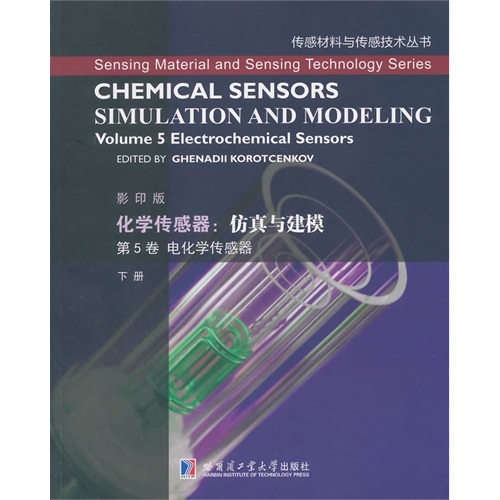
包邮第5卷 电化学传感器 下册-化学传感器:仿真与建模-影印版

温馨提示:5折以下图书主要为出版社尾货,大部分为全新(有塑封/无塑封),个别图书品相8-9成新、切口有划线标记、光盘等附件不全详细品相说明>>
- ISBN:9787560348995
- 装帧:一般胶版纸
- 册数:暂无
- 重量:暂无
- 开本:16开
- 页数:408
- 出版时间:2015-01-01
- 条形码:9787560348995 ; 978-7-5603-4899-5
本书特色
this series,chemical sensors:simulation and mod.eling,is the perfect complement to momentum press's six-volume reference series,chemical sensors:fundamentals of sensing materials and chemical sensors: comprehensive sensor technologies,which present detailed information about materials,technologies,fabrication,and applications of various devices for chemical sensing.chemical sensors are integral to the automation of myriad industrial processes and everyday monitoring of such activities as public safety,engine performance,medical therapeutics,and many more.
内容简介
This series,Chemical Sensors:Simulation and Mod.eling,is the perfect complement to Momentum Press's six-volume reference series,Chemical Sensors:Fundamentals of Sensing Materials and Chemical Sensors: Comprehensive Sensor Technologies,which present detailed information about materials,technologies,fabrication,and applications of various devices for chemical sensing.Chemical sensors are integral to the automation of myriad industrial processes and everyday monitoring of such activities as public safety,engine performance,medical therapeutics,and many more.
目录
about the editor
contributors
part 3: electrochemical biosensors
7 nanomaterial-based electrochemical biosensors n.jaffrezic-renault
1 introduction
2 nanomaterials: fabrication, chemical and physical properties
2.1 conducting nanomaterials
2.2 nonconducting nanomaterials: magnetic nanoparticles
3 conception and modeling of amplification effect in nanomaterial-based enzyme sensors
3.1 aunps-based amperometric sensors
3.2 cnt-based amperometric sensors
3.3 mnp-based amperometric biosensors
3.4 potentiometric sensors
3.5 conductometric and impedimetric biosensors
4 conception and modeling of amplification effect in nanomaterial-based immunosensors
4.1 aunp-based amperometric immunosensors
4.2 aunp-based potentiometric sensors
4.3 impedimetric sensors
4.4 conductometric sensors
5 conception and modeling of amplification effect in nanomaterial-based dna biosensors
5.1 amperometric sensors
5.2 impedimetric sensors
6 conclusion
references
8 ion-sensitive field-effect transistors with nanostructured channels and nanoparticle-modified gate surfaces: theory,modeling and analysis
v k. khanna
1 introduction
2 structural configurations of the nanoscale isfet
2.1 the nanoporous silicon isfet
2.2 the cnt isfet
2.3 the si-nw isfet
3 physics of the si-nw biosensor
3.1 basic principle
3.2 analogy with the nanocantilever
3.3 preliminary analysis of micro-isfet downscaling to nano-isfet
3.4 single-gate and dual-gate nanowire sensors
3.5 energy-band model of the nw sensor
4 nair-alam model of si-nw biosensors
4.1 the three regions in the biosensor
4.2 computational approach
4.3 effect of nanowire diameter (d) on sensitivity at different doping densities, with air as the surrounding medium
4.4 effect of nanowire length (l) on sensitivity at different doping densities, with air as the surrounding medium
4.5 effect of the fluidic environment
4.6 overall model implications
5 ph response of silicon nanowires in terms of the site-binding and gouy-chapman-stern models
6 subthreshold regime as the optimal sensitivity regime of nanowire biosensors
7 effective capacitance model for apparent surpassing of the nernst limit by sensitivity of the dual-gate nw sensor
8 tunnel field-effect transistor concept
9 role of nanoparticles in isfet gate functionalization
……
9 biosensors: modeling and simulation of diffusion-limited processes
index
作者简介
Ghenadii Korotcenkov,received his Ph.D. in Physics and Technology of Semiconductor Materials and Devices in 1976, and his Habilitate Degree (Dr.Sci.) in Physics and Mathematics of Semiconductors and Dielectrics in 1990. For a long time he was a leader of the scientific Gas Sensor Group and manager of various national and international scientific and engineering projects carried out in the Laboratory of Micro-and Optoelectronics,Technical University of Moldova.Currently, Dr. Korotcenkov is a research professor at the Gwangju Institute of Science and Technology,Republic of Korea. Specialists from the former Soviet Union know Dr. Korotcenkov's research results in the field of study of Schottky barriers,MOS structures, native oxides,and photoreceivers based on Group III-V compounds very well. His current research interests include materials science and surface science,focused on nanostructured metal oxides and solid-state gas sensor design. Dr. Korotcenkov is the author or editor of 11 books and special issues,11 invited review papers,17 book chapters,and more than 190 peer-reviewed articles. He holds 18 patents,and he has presented more than 200 reports at national and international conferences. Dr. Korotcenkov's research activities have been honored by an Award of the Supreme Council of Science and Advanced Technology of the Republic of Moldova (2004),The Prize of the Presidents of the Ukrainian, Belarus, and Moldovan Academies of Sciences (2003), Senior Research Excellence Awards from the Technical University of Moldova (2001,2003,2005),a fellowship from the International Research Exchange Board (1998), and the National Youth Prize of the Republic of Moldo
-

金属切削液配方与制备手册
¥144.5¥198.0 -

图解新能源汽车 原理·构造·诊断·维修
¥96.0¥128.0 -

中国传统酿造酒醋酱
¥38.1¥128.0 -

公路路基设计规范
¥54.9¥98.0 -

地下金属矿山灾害防治技术
¥26.5¥75.0 -

零担货物运输网络中绿色物流的枢纽选址与路径规划:英文版
¥57.2¥78.0 -

图解汽车线束技术
¥55.6¥78.0 -

土壤与地下水污染生态环境损害鉴定评估技术
¥35.6¥48.0 -

再话土力学
¥54.9¥98.0 -

中国近现代超级工程地理分布图
¥16.8¥20.0 -

矿产勘查项目设计实习指导书
¥24.0¥32.0 -

汽车故障综合诊断技术
¥63.7¥95.0 -

用于固态锂金属电池的钛酸镧锂基电解质研究
¥48.0¥58.0 -

汉服经典纹样与配色图鉴
¥117.6¥168.0 -

LNG船舶夜航安全评估
¥32.4¥56.0 -

高速列车空气动力学设计技术
¥102.4¥128.0 -

新型电力系统与新型能源体系
¥27.5¥98.0 -

科学论证:逻辑与科学评价方法:logic and scientific evaluation method
¥89.6¥128.0 -

河南省水资源——第三次水资源调查评价
¥144.0¥200.0 -

基于整体性治理的农村水环境共治模式研究
¥61.8¥78.0














